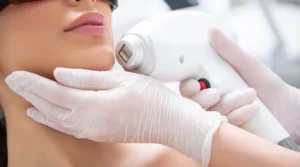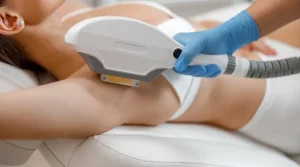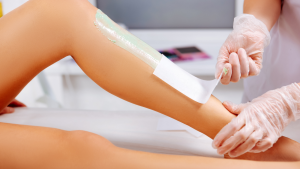Facial hair in women is more common than you may think. All women have some degree of facial hair, but for many, it’s so light and fine that it’s barely noticeable. However, some women experience darker, coarser facial hair, which can be a source of frustration and insecurity. If you’re part of the latter group, you may wonder why this happens and what you can do about it.
At Bergen County Hair Removal, we understand how challenging it can be to deal with facial hair, especially when it becomes more prominent. In this comprehensive guide, we will explore the most common causes of facial hair in women, medical conditions associated with excess hair growth, and the most effective treatments, including laser hair removal.
Key Takeaways: Facial Hair in Women – Causes and Solutions
- Hirsutism: Excess coarse facial hair in women, especially on the upper lip, chin, and neck, is often due to hirsutism, a condition affecting around 10% of women, linked to high levels of male hormones (androgens).
- Causes: Hormonal imbalances like Polycystic Ovarian Syndrome (PCOS), adrenal gland disorders, medications, pregnancy, menopause, and genetics are common causes of excess facial hair. PCOS is responsible for 75% of hirsutism cases.
- Hormonal Changes: Pregnancy and menopause can trigger facial hair growth. While pregnancy-related hair usually returns to normal after childbirth, menopause can lead to lasting facial hair.
- Genetics: Family history and ethnicity also influence facial hair growth. Studies show that some ethnicities, such as Indian women, experience more facial hair compared to others.
- Laser Hair Removal: This is a highly effective, long-term solution for unwanted facial hair. The non-invasive treatment leaves skin smoother and can boost self-esteem.
- Pre-Treatment: Before laser therapy, avoid waxing, plucking, tanning, and using sun-sensitive products. Shaving on the day of treatment is recommended for best results.
Lasting Results: Laser hair removal offers a lasting solution to unwanted facial hair, reducing the need for constant plucking, waxing, or dealing with ingrown hairs.
What Causes Facial Hair in Women?
Facial hair in women can be caused by several factors, from genetics to medical conditions. Here, we’ll break down the most common causes.
1. Hirsutism
Hirsutism refers to the growth of excessive, coarse hair in women in areas where men typically grow hair—such as the face, chest, back, and abdomen. Approximately 5-10% of women experience hirsutism, which is often associated with an increase in androgen (male hormone) levels. These hormones can cause thick, dark hair to grow in areas like the upper lip, chin, neck, and even chest or lower abdomen.
Causes of Hirsutism
There are several possible causes of hirsutism, which we’ll discuss in detail below:
2. Polycystic Ovarian Syndrome (PCOS)
Polycystic Ovarian Syndrome (PCOS) is the most common cause of hirsutism. It affects 5-15% of women of reproductive age. Women with PCOS experience hormonal imbalances that lead to the growth of small, benign cysts on their ovaries. These cysts can cause excess production of androgens, which leads to symptoms like:
- Excess facial and body hair (hirsutism)
- Irregular menstrual cycles
- Acne
- Weight gain
- Difficulty conceiving
If you suspect PCOS is contributing to your facial hair growth, consult your healthcare provider. By managing the hormonal imbalance through lifestyle changes, medications, or hormone therapy, many women are able to reduce their symptoms, including excess facial hair.
3. Adrenal Gland Disorders
Your adrenal glands, located just above your kidneys, are responsible for producing hormones, including androgens. If the adrenal glands are not functioning properly, they may produce too many male hormones, leading to hirsutism.
Two common adrenal gland disorders linked to facial hair growth are:
- Cushing’s Syndrome: Caused by prolonged exposure to high cortisol levels, which can lead to excess hair growth.
- Congenital Adrenal Hyperplasia (CAH): A genetic disorder that affects adrenal gland function and can result in the overproduction of androgens.
If you’re diagnosed with an adrenal gland disorder, your doctor may recommend treatments that target hormone levels to reduce unwanted hair growth.
4. Medications
Certain medications can stimulate facial hair growth by increasing androgen levels. Common medications that may cause this side effect include:
Anabolic steroids: Often used to build muscle mass, but they can lead to increased facial and body hair.
Testosterone supplements: Prescribed for conditions requiring testosterone, but can cause male-pattern hair growth in women.
Cyclosporine: An immunosuppressant drug that can trigger excess hair growth.
If you suspect your medication is causing unwanted hair growth, speak to your doctor about alternatives.
5. Idiopathic Hirsutism
In some cases, women experience excessive facial hair growth without any identifiable cause. This condition is known as idiopathic hirsutism. It tends to be a long-term condition, and the exact reason why it occurs is still unknown. In these cases, managing the symptoms through hair removal treatments is usually the best option.
6. Hormonal Changes
Hormonal fluctuations can significantly impact hair growth. This is why many women notice changes in facial hair during periods of significant hormonal shifts, such as:
- Pregnancy: Increased estrogen levels during pregnancy can cause body hair to grow more quickly and remain in a prolonged growth phase, leading to thicker hair. This includes facial hair. However, these changes are usually temporary and revert after childbirth.
- Menopause: During menopause, women experience a drop in estrogen levels and a relative increase in androgens. This can lead to the development of facial hair, especially around the chin and upper lip.
For women going through menopause, facial hair growth can be distressing, but various treatments, including hormone therapy and hair removal techniques, can help.
7. Genetics
Facial hair growth patterns are often inherited. Genetics and ethnicity play a large role in determining how much facial hair a woman has. For example, studies have shown that women of Mediterranean, Middle Eastern, and South Asian descent tend to have more noticeable facial hair than women of East Asian descent.
If genetics are at play, permanent hair removal treatments like laser therapy may offer the best long-term solution.
How to Get Rid of Facial Hair: Treatment Options
Regardless of the cause of excess facial hair, many women seek ways to remove or reduce it. There are several treatment options available, ranging from temporary fixes to more permanent solutions.
1. Laser Hair Removal
Laser hair removal is one of the most effective long-term treatments for unwanted facial hair. It works by targeting the pigment in the hair follicle, using heat to destroy the hair at its root. Over time, this can lead to permanent hair reduction.
Benefits of Laser Hair Removal:
- Precision: Lasers can target coarse, dark hairs while leaving the surrounding skin undamaged.
- Speed: Each pulse of the laser takes a fraction of a second and can treat many hairs at once.
- Long-Term Solution: After several sessions, many women experience permanent hair reduction.
Before undergoing laser hair removal, you should:
- Avoid waxing or plucking for at least three weeks before your appointment.
- Refrain from using tanning lotions or tanning beds.
- Discontinue the use of any sun-sensitizing medications.
- Shave the treatment area the day of your appointment.
Laser hair removal may require several sessions to achieve the desired results, but it’s a great solution for those looking to eliminate the need for daily shaving or painful waxing.
2. Electrolysis
Electrolysis is another permanent hair removal method. It works by sending an electric current into each hair follicle, destroying the root and preventing hair from growing back. Unlike laser hair removal, electrolysis can treat all hair colors and types, making it a versatile option for many women.
Benefits of Electrolysis:
- Permanent Results: Electrolysis provides permanent hair removal, whereas laser hair removal usually leads to permanent hair reduction.
- Versatility: It works on all skin tones and hair types.
However, electrolysis is often a slower process than laser hair removal, as each individual hair follicle must be treated. Multiple sessions are needed for optimal results.
3. Topical Creams
There are prescription creams available, such as eflornithine (Vaniqa), that can help slow the growth of facial hair. These creams work by inhibiting the enzyme responsible for hair growth, but they must be used continuously to maintain results. It’s important to note that these creams do not remove existing hair—they only slow future growth.
4. Waxing, Plucking, and Threading
For temporary hair removal, many women opt for traditional methods like waxing, plucking, or threading. While these methods can provide immediate results, they can also lead to side effects such as skin irritation, ingrown hairs, and the need for frequent maintenance. These methods also don’t address the root cause of excess hair growth.
5. Hormonal Treatments
If your facial hair growth is caused by hormonal imbalances, addressing the underlying issue can help. For example, women with PCOS may be prescribed birth control pills or anti-androgen medications to help regulate hormone levels and reduce hair growth. Speak to your healthcare provider about which hormonal treatment options might be appropriate for you.
Frequently Asked Questions (FAQ) About Facial Hair in Women
1. Is it normal for women to have facial hair?
Yes, all women have some facial hair. However, when the hair is darker and coarser, it may be classified as hirsutism, especially if it grows in areas where men typically grow hair.
2. What is the most common cause of excessive facial hair in women?
Polycystic Ovarian Syndrome (PCOS) is the most common cause of hirsutism in women. Other causes include adrenal gland disorders, medications, and genetics.
3. Can laser hair removal completely remove facial hair?
Laser hair removal can significantly reduce facial hair over time, and many people experience long-lasting results. However, it may not completely remove all hair permanently, and occasional maintenance sessions may be required.
4. How many laser hair removal sessions will I need?
The number of sessions needed varies depending on the individual and the treatment area. On average, 6 to 8 sessions are required for optimal results.
5. Is electrolysis better than laser hair removal?
Both electrolysis and laser hair removal are effective, but electrolysis is the only FDA-approved method for permanent hair removal. However, laser hair removal is faster and can treat larger areas more quickly.
6. Are there any side effects of laser hair removal?
Some people may experience temporary redness,
Conclusion:
Facial hair in women is a common concern, but it’s important to remember that you’re not alone in experiencing this issue. While all women have some degree of facial hair, it becomes a problem for many when the hair is darker, coarser, and more noticeable. Hirsutism, hormonal changes, genetics, and other medical conditions often drive the increase in facial hair, but identifying the root cause can help you determine the best solution.
For many, addressing facial hair through laser hair removal can provide a long-lasting, effective solution that not only enhances your appearance but also boosts your self-confidence. Whether your facial hair growth is the result of PCOS, adrenal disorders, medications, or simply genetics, Bergen County Hair Removal offers advanced treatments to help you achieve smoother, hair-free skin.





